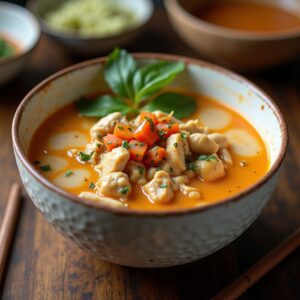

The Beginner’s Guide to an Anti-Inflammatory Lifestyle


Arya Soleil
Inflammation is a natural response by the body to injury, infection, or toxins. However, chronic inflammation can contribute to various health conditions, including heart disease, diabetes, arthritis, and even some cancers. Adopting an anti-inflammatory diet is a powerful way to combat this issue, reduce inflammation, and promote overall health.
If you’re new to the anti-inflammatory diet, this guide will walk you through everything you need to know to get started.
While anyone can benefit from an anti-inflammatory diet, certain individuals may find it especially helpful, including:
Individuals with Chronic Illnesses – People diagnosed with heart disease, diabetes, arthritis, or autoimmune disorders can benefit significantly from reducing inflammation through diet.
Those with Digestive Issues – Conditions such as irritable bowel syndrome (IBS), Crohn’s disease, and leaky gut syndrome can improve with anti-inflammatory foods that support gut health.
People with Joint Pain or Arthritis – Chronic joint pain and conditions like rheumatoid arthritis respond well to anti-inflammatory eating.
Individuals with Skin Conditions – Acne, eczema, and psoriasis may improve with a diet that limits inflammatory foods.
Those with Metabolic Syndrome or Obesity – An anti-inflammatory diet can help regulate blood sugar levels, reduce insulin resistance, and support weight management.
People Experiencing Chronic Stress – High stress levels can trigger inflammation; consuming anti-inflammatory foods can help regulate the body’s response.
Individuals Concerned About Cognitive Health – Alzheimer’s disease and other neurodegenerative conditions are linked to inflammation, making dietary adjustments crucial for brain health.
An anti-inflammatory diet focuses on consuming whole, nutrient-dense foods that help regulate inflammation levels in the body while avoiding foods that trigger excessive inflammation. This way of eating is rich in antioxidants, healthy fats, fiber, and essential vitamins and minerals.
Unlike restrictive fad diets, the anti-inflammatory diet is not about eliminating entire food groups. Instead, it emphasizes balance, quality, and variety in the foods you eat.
Inflammation can be categorized into two types:
Acute Inflammation: This is a short-term immune response that helps the body heal from injuries or infections.
Chronic Inflammation: This long-term, low-grade inflammation can contribute to serious diseases like heart disease, diabetes, Alzheimer’s, and autoimmune disorders.
Certain foods, especially those high in refined sugars, unhealthy fats, and processed ingredients, can fuel chronic inflammation, while whole, natural foods can help neutralize inflammation and support healing.
The foundation of an anti-inflammatory diet includes whole, unprocessed foods that provide essential nutrients for reducing inflammation.
A. Fruits & Vegetables (Antioxidants & Fiber)
Fruits and vegetables are packed with antioxidants, polyphenols, and fiber, all of which help combat oxidative stress and inflammation.
Berries: Blueberries, strawberries, blackberries, raspberries
Leafy Greens: Spinach, kale, Swiss chard, arugula
Cruciferous Vegetables: Broccoli, cauliflower, Brussels sprouts
Colorful Vegetables: Carrots, bell peppers, beets, tomatoes
Citrus Fruits: Oranges, lemons, grapefruits
B. Healthy Fats (Omega-3s & Monounsaturated Fats)
Not all fats are bad. Some fats are essential for reducing inflammation and promoting heart health.
Olive oil (extra virgin)
Avocados
Nuts: Almonds, walnuts, cashews
Seeds: Chia seeds, flaxseeds, hemp seeds
Fatty fish: Salmon, sardines, mackerel, trout
C. Whole Grains (Fiber & Nutrients)
Refined grains can spike blood sugar levels and contribute to inflammation, while whole grains provide fiber and essential nutrients.
Quinoa
Brown rice
Oats
Whole wheat (if tolerated)
Barley & farro
D. Lean Proteins (Plant & Animal Sources)
Fish (wild-caught salmon, sardines, tuna)
Poultry (organic chicken, turkey)
Legumes (lentils, chickpeas, black beans, kidney beans)
Tofu & tempeh
Pasture-raised eggs
E. Herbs & Spices (Natural Anti-Inflammatories)
Certain spices contain bioactive compounds that have anti-inflammatory effects.
Turmeric (best absorbed with black pepper)
Ginger
Garlic
Cinnamon
Rosemary, basil, thyme, oregano
F. Beverages (Hydration & Anti-Inflammatory Benefits)
Green tea (rich in antioxidants like catechins)
Herbal teas (ginger, turmeric, chamomile, peppermint)
Water with lemon
Bone broth (supports gut health & immunity)
Starting an anti-inflammatory diet doesn’t have to be overwhelming. The key is to make small, sustainable changes, focus on whole, nutrient-dense foods, and listen to your body’s needs.
By making these dietary and lifestyle adjustments, you can reduce chronic inflammation, improve overall health, and lower the risk of various diseases. Whether you’re looking to manage existing health conditions or simply enhance your well-being, an anti-inflammatory diet is a powerful and long-term approach to health.
Would you like to learn more about how to personalize an anti-inflammatory diet for your needs? Drop a comment below and let’s continue the conversation!
Recommended Reads

- March 22, 2025
Anti-Inflammatory Breakfasts: Easy Recipes to Start Your Day Right
Home News Healthy Habits & Lifestyle Health Conditions &...


- March 22, 2025
Questioning the FDA: A Deeper Look at the Food and Drug Administration’s Role
Home News Healthy Habits & Lifestyle Health Conditions &...


- March 22, 2025
Make ‘Raw Milk’ Just ‘Milk’ Again: A Closer Look at the Raw Milk Debate
Home News Healthy Habits & Lifestyle Health Conditions &...


- March 22, 2025
The Power of Sweet Potatoes: A Superfood for Eyes, Skin, and Beyond
Home News Healthy Habits & Lifestyle Health Conditions &...


- March 22, 2025
Sugar-Free: A Code Word for “We’ve Replaced It with Something Worse for You”
Home News Healthy Habits & Lifestyle Health Conditions &...


- March 22, 2025
The Evolution of Food: How Modern Diets Are Fueling Chronic Disease
Home News Healthy Habits & Lifestyle Health Conditions &...

The Beginner’s Guide to the Anti-Inflammatory Diet

Inflammation is a natural response by the body to injury, infection, or toxins. However, chronic inflammation can contribute to various health conditions, including heart disease, diabetes, arthritis, and even some cancers. Adopting an anti-inflammatory diet is a powerful way to combat this issue, reduce inflammation, and promote overall health.
If you’re new to the anti-inflammatory diet, this guide will walk you through everything you need to know to get started.
While anyone can benefit from an anti-inflammatory diet, certain individuals may find it especially helpful, including:
Individuals with Chronic Illnesses – People diagnosed with heart disease, diabetes, arthritis, or autoimmune disorders can benefit significantly from reducing inflammation through diet.
Those with Digestive Issues – Conditions such as irritable bowel syndrome (IBS), Crohn’s disease, and leaky gut syndrome can improve with anti-inflammatory foods that support gut health.
People with Joint Pain or Arthritis – Chronic joint pain and conditions like rheumatoid arthritis respond well to anti-inflammatory eating.
Individuals with Skin Conditions – Acne, eczema, and psoriasis may improve with a diet that limits inflammatory foods.
Those with Metabolic Syndrome or Obesity – An anti-inflammatory diet can help regulate blood sugar levels, reduce insulin resistance, and support weight management.
People Experiencing Chronic Stress – High stress levels can trigger inflammation; consuming anti-inflammatory foods can help regulate the body’s response.
Individuals Concerned About Cognitive Health – Alzheimer’s disease and other neurodegenerative conditions are linked to inflammation, making dietary adjustments crucial for brain health.
An anti-inflammatory diet focuses on consuming whole, nutrient-dense foods that help regulate inflammation levels in the body while avoiding foods that trigger excessive inflammation. This way of eating is rich in antioxidants, healthy fats, fiber, and essential vitamins and minerals.
Unlike restrictive fad diets, the anti-inflammatory diet is not about eliminating entire food groups. Instead, it emphasizes balance, quality, and variety in the foods you eat.
Inflammation can be categorized into two types:
Acute Inflammation: This is a short-term immune response that helps the body heal from injuries or infections.
Chronic Inflammation: This long-term, low-grade inflammation can contribute to serious diseases like heart disease, diabetes, Alzheimer’s, and autoimmune disorders.
Certain foods, especially those high in refined sugars, unhealthy fats, and processed ingredients, can fuel chronic inflammation, while whole, natural foods can help neutralize inflammation and support healing.
The foundation of an anti-inflammatory diet includes whole, unprocessed foods that provide essential nutrients for reducing inflammation.
A. Fruits & Vegetables (Antioxidants & Fiber)
Fruits and vegetables are packed with antioxidants, polyphenols, and fiber, all of which help combat oxidative stress and inflammation.
Berries: Blueberries, strawberries, blackberries, raspberries
Leafy Greens: Spinach, kale, Swiss chard, arugula
Cruciferous Vegetables: Broccoli, cauliflower, Brussels sprouts
Colorful Vegetables: Carrots, bell peppers, beets, tomatoes
Citrus Fruits: Oranges, lemons, grapefruits
B. Healthy Fats (Omega-3s & Monounsaturated Fats)
Not all fats are bad. Some fats are essential for reducing inflammation and promoting heart health.
Olive oil (extra virgin)
Avocados
Nuts: Almonds, walnuts, cashews
Seeds: Chia seeds, flaxseeds, hemp seeds
Fatty fish: Salmon, sardines, mackerel, trout
C. Whole Grains (Fiber & Nutrients)
Refined grains can spike blood sugar levels and contribute to inflammation, while whole grains provide fiber and essential nutrients.
Quinoa
Brown rice
Oats
Whole wheat (if tolerated)
Barley & farro
D. Lean Proteins (Plant & Animal Sources)
Fish (wild-caught salmon, sardines, tuna)
Poultry (organic chicken, turkey)
Legumes (lentils, chickpeas, black beans, kidney beans)
Tofu & tempeh
Pasture-raised eggs
E. Herbs & Spices (Natural Anti-Inflammatories)
Certain spices contain bioactive compounds that have anti-inflammatory effects.
Turmeric (best absorbed with black pepper)
Ginger
Garlic
Cinnamon
Rosemary, basil, thyme, oregano
F. Beverages (Hydration & Anti-Inflammatory Benefits)
Green tea (rich in antioxidants like catechins)
Herbal teas (ginger, turmeric, chamomile, peppermint)
Water with lemon
Bone broth (supports gut health & immunity)
Starting an anti-inflammatory diet doesn’t have to be overwhelming. The key is to make small, sustainable changes, focus on whole, nutrient-dense foods, and listen to your body’s needs.
By making these dietary and lifestyle adjustments, you can reduce chronic inflammation, improve overall health, and lower the risk of various diseases. Whether you’re looking to manage existing health conditions or simply enhance your well-being, an anti-inflammatory diet is a powerful and long-term approach to health.
Recommended Reads

- March 22, 2025
Anti-Inflammatory Breakfasts: Easy Recipes to Start Your Day Right
Home News Healthy Habits & Lifestyle Health Conditions &...


- March 22, 2025
Questioning the FDA: A Deeper Look at the Food and Drug Administration’s Role
Home News Healthy Habits & Lifestyle Health Conditions &...


- March 22, 2025
Make ‘Raw Milk’ Just ‘Milk’ Again: A Closer Look at the Raw Milk Debate
Home News Healthy Habits & Lifestyle Health Conditions &...


- March 22, 2025
The Power of Sweet Potatoes: A Superfood for Eyes, Skin, and Beyond
Home News Healthy Habits & Lifestyle Health Conditions &...


- March 22, 2025
Sugar-Free: A Code Word for “We’ve Replaced It with Something Worse for You”
Home News Healthy Habits & Lifestyle Health Conditions &...


- March 22, 2025
The Evolution of Food: How Modern Diets Are Fueling Chronic Disease
Home News Healthy Habits & Lifestyle Health Conditions &...



